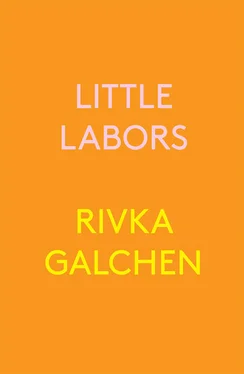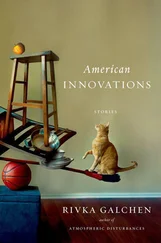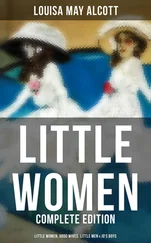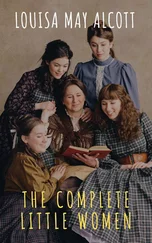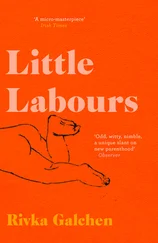Rivka Galchen - Little Labors
Здесь есть возможность читать онлайн «Rivka Galchen - Little Labors» весь текст электронной книги совершенно бесплатно (целиком полную версию без сокращений). В некоторых случаях можно слушать аудио, скачать через торрент в формате fb2 и присутствует краткое содержание. Год выпуска: 2016, Издательство: New Directions, Жанр: Публицистика, Критика, на английском языке. Описание произведения, (предисловие) а так же отзывы посетителей доступны на портале библиотеки ЛибКат.
- Название:Little Labors
- Автор:
- Издательство:New Directions
- Жанр:
- Год:2016
- ISBN:нет данных
- Рейтинг книги:5 / 5. Голосов: 1
-
Избранное:Добавить в избранное
- Отзывы:
-
Ваша оценка:
- 100
- 1
- 2
- 3
- 4
- 5
Little Labors: краткое содержание, описание и аннотация
Предлагаем к чтению аннотацию, описание, краткое содержание или предисловие (зависит от того, что написал сам автор книги «Little Labors»). Если вы не нашли необходимую информацию о книге — напишите в комментариях, мы постараемся отыскать её.
—a key inspiration for Rivka Galchen’s new book — contains a list of “Things That Make One Nervous.” And wouldn’t the blessed event top almost anyone’s list?
Little Labors
Genji
The Pillow Book
Little Labors — atomized and exploratory, conceptually byzantine and freshly forthright — delights.
Little Labors — читать онлайн бесплатно полную книгу (весь текст) целиком
Ниже представлен текст книги, разбитый по страницам. Система сохранения места последней прочитанной страницы, позволяет с удобством читать онлайн бесплатно книгу «Little Labors», без необходимости каждый раз заново искать на чём Вы остановились. Поставьте закладку, и сможете в любой момент перейти на страницу, на которой закончили чтение.
Интервал:
Закладка:
In Flagstaff, two
The oviraptor is one of the small Mongolian theropod dinosaurs. Its name means, more or less, “egg thief.” It turns out this name is unfair. The first oviraptor fossil was discovered near a nest, which is how the name came about. But years later it was decided that the oviraptor was most likely near its own nest when it died, that the eggs in the nest were most likely its own eggs.
I learn this from a label on a model of the original oviraptor fossil at a gift shop labeled Museum Gift Shop Information, located just outside of the Petrified National Forest. The gift shop has stones, fossils, mugs, moccasins, key chains, polished quartz, unpolished quartz, Navajo-style blankets for $10, and Navajo-style blankets for $400—it is about 4,000 square feet of floorspace organized like the attic of a nostalgic geologist. We are the only customers there on a bright, clear day. There are two people working there, a very thin woman wearing a thick blonde wig, and a young man who appears to be her son and who inspects my driver’s license to coordinate it with my credit card for a very long time; though we came in for a map, we are buying a toddler-sized pair of red moccasins. When we ask how long the drive is through the Petrified Forest and the Painted Desert, the thin woman says that we shouldn’t miss the information booth, the official one, which is just inside the park. She says, So many people think that this is the information booth, because we have the word Information on our roof, but the information booth is just further in, and there you can find a map.
New variety of depression
It’s true what they say, that a baby gives you a reason to live. But also, a baby is a reason that it is not permissible to die. There are days when this does not feel good.
A baby is an ideal vector for a revenge plot
In some sense, The Tale of Genji has no plot. Genji is born, then this happens and that happens and then he gets old and he dies and other people continue on, living their lives, in which further thises and thats happen.
But in another sense Genji has a perfectly rounded plot: it describes a simple triptych with the unavoidable ambiguity of paternity as its hinges. Genji is born to the most beloved of the emperor’s consorts, but she dies shortly after Genji is born; because she was of low status, her son Genji is also of problematically low status. But the emperor then marries a woman who looks like Genji’s deceased mother, and later Genji has an affair with that stepmother, and he and the stepmother then pretend that the resultant child is the emperor’s. That child eventually becomes emperor. As emperor he grants status to Genji, his real father. Genji, by this time, has gone on to marry a woman he met when she was a young girl and whom he raised as if she were his daughter. Later Genji’s third wife has a child with Genji’s evil nephew and they pretend that child is Genji’s. That child, who becomes a basically mediocre and evil man, lives on after Genji’s death with the status of a son of Genji.
So twice major characters fall in love with people who are essentially, if not biologically, their children. And twice the ambiguity of paternity enables a radical shift of power: once it elevates Genji, via his secret son, and once it diminishes Genji, via his secretly not-son. That first shift is a revenge against inheritance, the second shift is a revenge upon that revenge. It is a wise child that knows its own father, goes the saying. And a wise mother who makes use of the mystery. The novel ends in midsentence, and no one really knows if the final words are those of Lady Murasaki, or if the last chapters were written not by Murasaki herself but instead, after her death, by her daughter.
A modern anxiety
Paternal ambiguity is age-old. Maternal ambiguity is pretty new. Of course babies could be switched, and stories of changelings were useful ways of understanding strange children, but still, carrying a child in one’s body meant that even the most magical thoughts were alloyed with maternal certainty. In vitro fertilization has altered this.
Or, at least, I found myself, starting when the baby was about eleven days old, and then for months afterward, thinking in detail through the following problem: If it turned out I had carried someone else’s child, what should I do? (The doctor had seemed a hasty, careless type.) What would constitute ethical behavior? Would it be wrong to flee the country with the baby, in order to stay together? We were already so in love — wasn’t love its own validity? If I gave the baby over to her “real” mother, was I allowed to stay in touch, or was I required to let her go entirely? It was so obvious what the right thing to do was, and so obvious, also, that I would not do it. This was distressing even though I also knew that I would never be so called upon.
One could argue that this is a straightforward prefiguration of the difficulties of allowing a child to grow up and away. Or that it’s evidence that even with insufficient sleep and no free time, a certain kind of mind will find its way toward an excess of immaterial quandaries. Or maybe I was just working through my problematic inability to hand the child over to another caretaker, even for just a few hours.
Things that one was misleadingly told were a big part of having a baby
Diapers. Changing them. Bottles. Cleaning them. Wraps. Baths. Sleeplessness. Cheerios. All these things exist, but rise to consciousness about as often as the apartment’s electricity does.
Babies in art
Babies in art mostly look nothing like babies in life. This is especially true of the baby Jesus, but also of babies more broadly, and this is true even, and maybe most noticeably, in paintings and sculptures that are, apart from the oddly depicted babies, realistic. Often babies are depicted with the proportions of small adults: their limbs are relatively longer than baby limbs, and their heads are not as relatively large as baby heads; in real life babies have heads so large, and arms so short, that they can’t reach their arms beyond their heads. But one almost never sees this in a museum. I am told, also, that a major problem through the centuries for artists depicting the baby Jesus has been the question of what to do about the Lord’s penis.
Recently, though, the baby and I saw several realistic paintings of babies. One of these was by the seventeenth-century artist Jan Steen, who is most famous for his paintings of chaotic, messy households — households as they really were, one imagines. Also we saw a Jan de Bray painting titled The Adoration of the Shepherds , which depicted the infant Jesus looking like a real infant; Adoration was hung near Still Life with Strawberries by Adriaen Coorte. All the paintings were in the same room, which had, as the focal point of the gallery, a very large painting of a cow, by Paulus Potter. It had been radical at the time, the gallery copy noted, for a simple cow to be the subject of such attentive portraiture.
So there was a moment, in Dutch painting, when the problem of how to depict babies was solved by having them appear as they in fact are. But I think I’ve discovered a more pervasive and enduring realistic depiction of babies, though not in depictions of actual babies but instead in depictions of the virgin Mary. I had often wondered about the distinctive tilt of Mary’s head in so many paintings and sculptures. It’s a very particular, recognizable tilt, and you see it again and again, across time and geography. The tilt is usually coincident with Mary holding but not necessarily looking at the baby Jesus. In iconography, I imagine, the tilt has its own prescribed meaning. But that’s an insufficient explanation of the tilt, of why it came to be, of why it makes sense. It’s not a tilt I’ve ever observed in women in real life. But after I held my young baby again and again and again and again and again, I very clearly recognized the angle of the tilt of Mary’s head; it is the tilt of the head of babies who are just beginning to develop the strength of their neck muscles. When I hold my baby, she holds her head at that exact same angle.
Читать дальшеИнтервал:
Закладка:
Похожие книги на «Little Labors»
Представляем Вашему вниманию похожие книги на «Little Labors» списком для выбора. Мы отобрали схожую по названию и смыслу литературу в надежде предоставить читателям больше вариантов отыскать новые, интересные, ещё непрочитанные произведения.
Обсуждение, отзывы о книге «Little Labors» и просто собственные мнения читателей. Оставьте ваши комментарии, напишите, что Вы думаете о произведении, его смысле или главных героях. Укажите что конкретно понравилось, а что нет, и почему Вы так считаете.
